 ACKNOWLEDGMENTS
ACKNOWLEDGMENTS Without the assistance and encouragement of many persons, this book would not have become a reality. My deepest appreciation is here expressed to the following people:
Pearl Goings, the artist who spent many hours working with me drawing new pictures and updating those that had originally been prepared by
Betty Stewart for Talk to the Deaf
Sandy Flower, who devoted many hours to the final inking of the line drawings
Linda Martin, who patiently served as sounding board, script reader, critiquer, and who suggested the present format which makes the book readable and clear
Wayne Warner, book editor at Gospel Publishing House, for guidance along the way, and
Nancy Stevens, for the final editing of the first edition
David Johnston, publisher, who believed in the concept of a sign book in 1963 when no book with line drawings of signs had ever been published
Bill Eastlake, publisher in 1978, who strongly encouraged a revised edition and who made it possible
Glen Ellard, editor of the second edition, for providing overall guidance, and
Nancy Stevens, for the final editing
JoAnn Smith, who devoted many hours to the third edition revisions My many
deaf friends whose signing skills were an inspiration to me and whose knowledge of sign language, corrections of my signs, explanations, discussions of origins, and most of all acceptance of me as a hearing person brought about the original work and this revision. 1964, 1978, 2014 by Gospel Publishing House, 1445 N. Boonville Ave., Springfield, Missouri 65802. All rights reserved.
Videotape EditionThe Joy of Signing is available on video.
Videotape EditionThe Joy of Signing is available on video.
Information may be obtained by from Dave Stecca, 25W560 Geneva Rd., Suite 10, Carol Stream, Illinois 60188 ( Puzzle BooksThe Joy of Signing Puzzle Book (978-1-60731-379-3) and The Joy of Signing Puzzle Book 2 (978-1-60731-380-9) by Linda Lascelle Hillebrand with Lottie L. Riekehof, are available from Gospel Publishing House. Library of Congress Catalog in Publication Data Riekehof, Lottie L. The Joy of Signing: Third Edition First edition published in / 1978 under the title: The Joy of Signing. Published in 1963 under the title: Talk to the Deaf. Bibliography: p.
Includes index. 1. Sign language. 2. Deaf-means of communication. Title. Title.
HV2474.R53 1987 419
86-80173
ISBN: 978-1-60731-361-8 Printed in the United States of America
Contents
Introduction to the Third Edition
The acceptance of
The Joy of Signing has been and continues to be extremely gratifying. It has been used as the main vocabulary reference for sign language students in schools and colleges across the country, by parents of deaf children, by professionals, and also by deaf persons themselves. The signs included in this manual are not inventions of the author but observations of signing by deaf persons and professional interpreters with whom the author associated not only at Gallaudet University and in the Washington, D.C., area, but also in other parts of the country. Intended as a dictionary for anyone wishing to learn a basic sign vocabulary to communicate with deaf people, this manual will also help persons interested in preparing for entry into interpreter training programs. Sign language is a living, growing language and, as is true of spoken languages, its vocabulary will continue to increase. The adult deaf population is interested in enlarging the sign vocabulary but not in unnecessary innovations, initializations, and markers, particularly if the traditional basic sign provides sufficient clarity.
The section of this manual covering word endings and word-form changes will explain this further and will point out markers that have been in use over the years as well as those now recommended for use in some educational settings. The Joy of Signing does not attempt to include the many new signs developed in recent years for use with children. Its purpose is to provide the learner with the basic, traditional signs used by deaf adults as well as a knowledge of the base from which new signs have been developed. This knowledge will help the signer to judge whether some of the new signs are conceptually based. This is not to say that all new nonconceptually based signs are unacceptable, but it is important to know the basic signs that are acceptable to the deaf adult before venturing into newer signs and systems. Reactions to some of the new signs appearing in various texts today have been varied.
The consensus among deaf adults is that conceptually based new signs have a place, particularly for deaf children who should have as much language stimulation as possible in as precise a form as possible and in as many modes as possible in order to provide them with the tools they will need for their educational development. All the signs listed in this manual are not used by all deaf people, just as all words in a dictionary are not in the everyday vocabulary of all hearing people. The number of signs in ones vocabulary is not as important as the way the signs are used. A sign does not exist for every word in the English language, but a good signer will know how to choose the sign that most nearly expresses the desired thought. When a sign cannot be found to portray the exact meaning, fingerspelling is perfectly acceptable. Although beginners find this a chore, experienced signers frequently fingerspell even words that do have signs.
Certain short words, such as car, bus, and job, are usually fingerspelled. To find or to invent signs for such short words is not necessary since the fingerspelled configuration is read as a sign. Signs in this manual have been grouped by chapter into natural categories, but the search for an individual sign is best made by using the index. If the word you are searching for is not listed, look for the word closest in meaning and check the usage in that entry to see whether it would be an appropriate choice. This manual contains a number of glosses for many of the signs but is by no means meant to be exhaustive. The group of words listed for an entry will give you a general idea of the words that are included in the concept being signed.
Close observation of the ways deaf people use signs is the best way to improve your own skill.
Using the Manual
To learn signs accurately from this manual, study the complete entry. First, look at the picture to get a general idea of the sign (remembering that in front-view drawings the signers right hand appears on the left). Next, read the origin of the sign so you will understand the reason for a particular sign formation, or movement. Often the relationship between a sign and its meaning is quite obvious. When the origin is understood, a sign is more easily remembered.
An attempt has been made not only to present a clear drawing but also to provide a step-by-step description of the handshapes and movements. Read each description to see whether you are making the sign properly. The sentences included with each entry provide either a model of correct usage in context (needed for words having multiple meanings, such as like, train, kind,


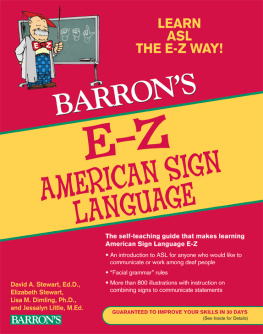
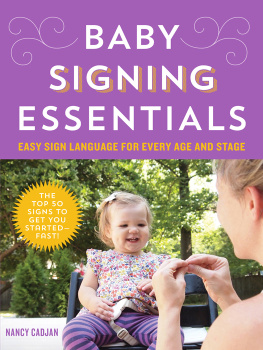
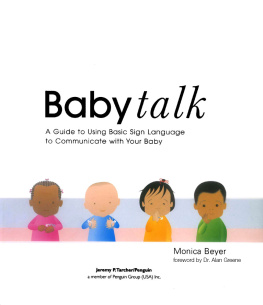
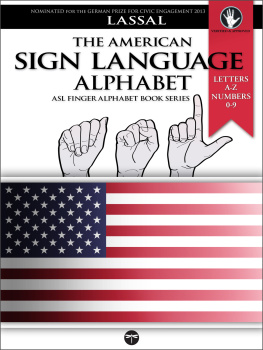
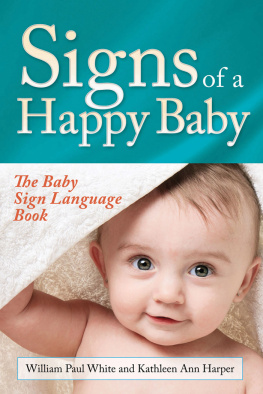
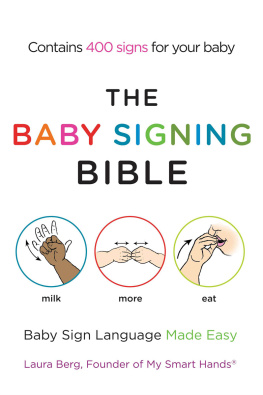
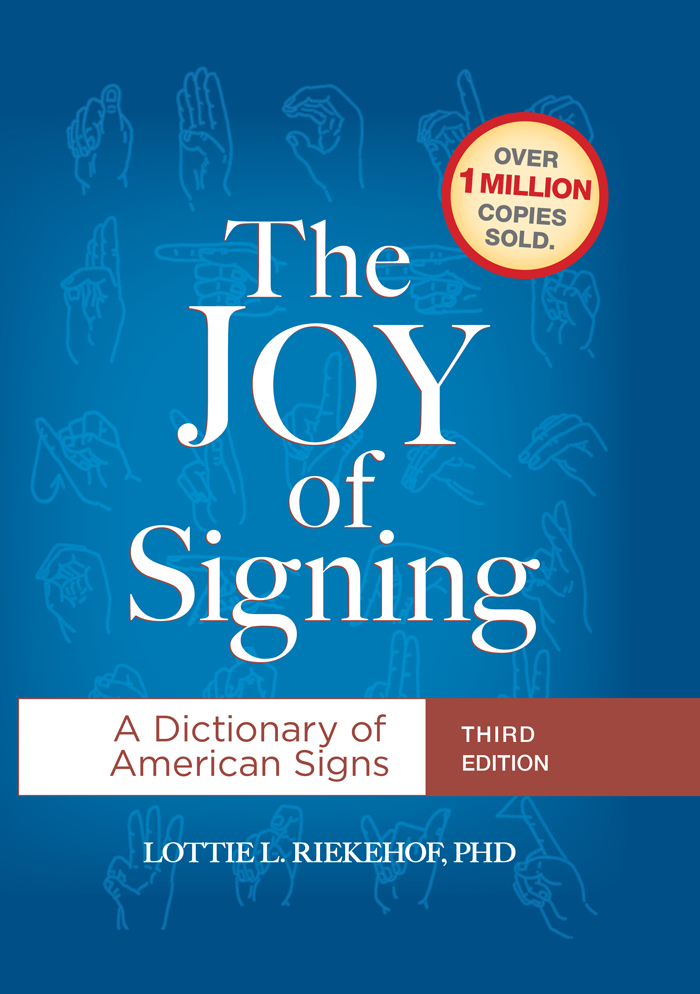
 ACKNOWLEDGMENTS Without the assistance and encouragement of many persons, this book would not have become a reality. My deepest appreciation is here expressed to the following people: Pearl Goings, the artist who spent many hours working with me drawing new pictures and updating those that had originally been prepared by Betty Stewart for Talk to the Deaf Sandy Flower, who devoted many hours to the final inking of the line drawings Linda Martin, who patiently served as sounding board, script reader, critiquer, and who suggested the present format which makes the book readable and clear Wayne Warner, book editor at Gospel Publishing House, for guidance along the way, and Nancy Stevens, for the final editing of the first edition David Johnston, publisher, who believed in the concept of a sign book in 1963 when no book with line drawings of signs had ever been published Bill Eastlake, publisher in 1978, who strongly encouraged a revised edition and who made it possible Glen Ellard, editor of the second edition, for providing overall guidance, and Nancy Stevens, for the final editing JoAnn Smith, who devoted many hours to the third edition revisions My many deaf friends whose signing skills were an inspiration to me and whose knowledge of sign language, corrections of my signs, explanations, discussions of origins, and most of all acceptance of me as a hearing person brought about the original work and this revision. 1964, 1978, 2014 by Gospel Publishing House, 1445 N. Boonville Ave., Springfield, Missouri 65802. All rights reserved. Videotape EditionThe Joy of Signing is available on video. Videotape EditionThe Joy of Signing is available on video.
ACKNOWLEDGMENTS Without the assistance and encouragement of many persons, this book would not have become a reality. My deepest appreciation is here expressed to the following people: Pearl Goings, the artist who spent many hours working with me drawing new pictures and updating those that had originally been prepared by Betty Stewart for Talk to the Deaf Sandy Flower, who devoted many hours to the final inking of the line drawings Linda Martin, who patiently served as sounding board, script reader, critiquer, and who suggested the present format which makes the book readable and clear Wayne Warner, book editor at Gospel Publishing House, for guidance along the way, and Nancy Stevens, for the final editing of the first edition David Johnston, publisher, who believed in the concept of a sign book in 1963 when no book with line drawings of signs had ever been published Bill Eastlake, publisher in 1978, who strongly encouraged a revised edition and who made it possible Glen Ellard, editor of the second edition, for providing overall guidance, and Nancy Stevens, for the final editing JoAnn Smith, who devoted many hours to the third edition revisions My many deaf friends whose signing skills were an inspiration to me and whose knowledge of sign language, corrections of my signs, explanations, discussions of origins, and most of all acceptance of me as a hearing person brought about the original work and this revision. 1964, 1978, 2014 by Gospel Publishing House, 1445 N. Boonville Ave., Springfield, Missouri 65802. All rights reserved. Videotape EditionThe Joy of Signing is available on video. Videotape EditionThe Joy of Signing is available on video.